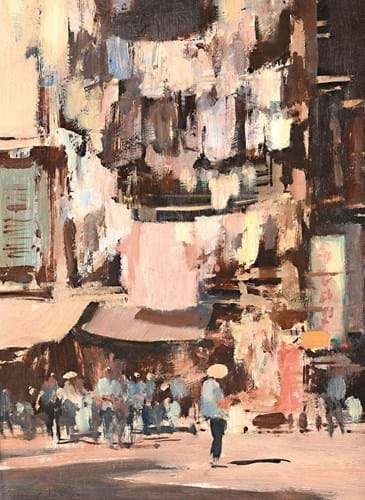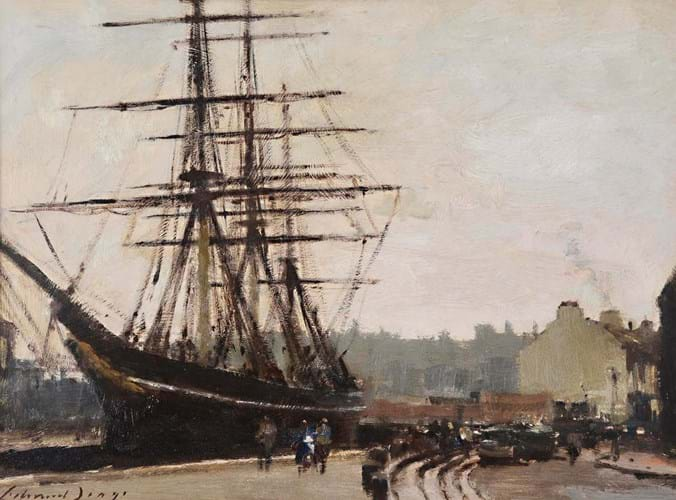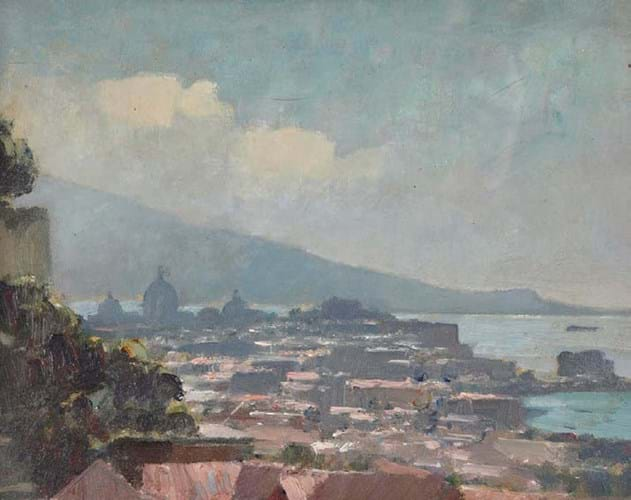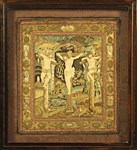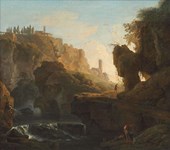In something of a footnote to all the reams of recent coverage of the death of Prince Philip, you may have read about his close friendship with the artist Edward Seago (1910-74).
The two men knew each other for a long time and, as well as sharing many connections and interests, seem to have developed a strong mutual admiration.
In 1956-7, Seago was invited to accompany the Duke of Edinburgh on a tour of the Antarctic and tutored him as they painted together on the deck of the Royal Yacht Britannia (he would later also teach Prince Charles).
Among the pictures they made, both men produced portraits of the other (showing their subjects at work painting). These works were displayed together most recently at the 2016 Portrait of The Artist exhibition at Buckingham Palace.
Seago was very much a family favourite. Each year the Norfolk artist visited Sandringham and would present the Queen Mother with one of his pictures. Famously he was appointed as the official artist for the Queen’s Coronation in 1953.
While he was favoured by three generations of the royal family – no artist received more royal patronage across the 20th century than Seago – his following was always wider than just establishment circles. It remains so to this day.
Solid demand
Indeed, few artists today appear as frequently at auction and meet such consistently solid demand. While a variety of collectors may choose to focus on his East Anglian landscapes, views of the Thames or topographical scenes of the Far East, his prices are bolstered by interest from a number of leading dealers who stay closely attuned to any works that emerge on the market.
This seems to explain the notable reaction to a group of 10 works by the artist offered at Dreweatts’ (25% buyer’s premium) Modern and Contemporary Art sale in Newbury on March 18.
The works were from across the artist’s career and, as a group, represented many of his different styles and subjects. The fact that all of them sold to eight different buyers, albeit some going under estimate, underlined the spread of interest.
The highlight was a Hong Kong street view that came from a London property as part of a deceased estate but with previous provenance to Marlborough Fine Art. The 14 x 10½in (36 x 27cm) signed oil on board was one of 80 works produced in a six-week period when Seago was invited to Hong Kong in 1962 by shipping magnate John Swire.
Swire had collected Seago’s work for many years and commissioned him to paint a series of pictures for his firm's new boardroom. He wanted to give Seago the chance to follow in the footsteps of 19th century topographical artists like George Chinnery but, while many of the coastal landscapes and maritime subjects were relatively traditional in style, the street scenes he produced were very different.
The current work was much more loosely handled and was created using a palette knife with the rapidly applied paint aimed at capturing the vibrant and chaotic everyday life of Hong Kong’s central district. The Hong Kong pictures were the first time Seago had adopted this technique.
These kind of pictures – which supporters would say rebuff claims that Seago struggled to find a place the context of Modern art and the growing interest in abstraction – are not so common on the market, and emerge less frequently than his views of the city’s waterfront. However, Seago views of Hong Kong remain sought after and this small example was deemed well conceived and had an attractive palette.
Estimated at £15,000-25,000, it drew a good competition before it sold at £44,000 to a UK dealer. The sum stands within the top 10 prices for Seago Hong Kong subjects at auction (source: Artprice by Artmarket) and, given the size of the work, the price per square inch was especially strong.
Nautical but nice
Marine subjects comprised four of the 10 works at Dreweatts, underling the love of all things nautical that he shared with Prince Philip. One of them, depicting the estuary of the River Orwell at Pin Mill in Suffolk, had provenance to two London dealers, Colnaghi and The Taylor Gallery, which it had passed through at different times.
Attracted by the wide perspectives and distinctive flat-bottomed Thames barges with their distinctive red sails, Seago painted many views he made of the estuary which may be why the £25,000-35,000 guide was deemed a little punchy on this occasion. It sold at £24,000.
Making a lesser sum but attracting more bidding was an oil sketch of The Cutty Sark at Greenwich. The artist painted the much-loved 19th century tea clipper on several occasions. This 10¾ x 14¼in (28 x 37cm) signed oil on board had been purchased by the vendor from Colnaghi and, pitched at £5000-8000, it sold at £10,000.
Mediterranean focus
While a couple of classic Norfolk landscapes were included in the sale, another aspect of Seago’s oeuvre was represented by three works in the group – all views of European subjects.
An oil of Torremolinos in Spain and a watercolour of Chioggia in Italy both sold marginally under estimate at £14,000 and £4800 respectively, but a panorama of Sorrento overlooking the southern Italian city’s rooftops and the Bay of Naples overshot a £3000-5000 estimate to take £9000.
The 8 x 10in (21 x 26cm) oil on board had been purchased from Marlborough Fine Art by a member of the vendor’s family and had passed via descent.
It was dated 45, meaning it was executed at a time when, after five years’ war service as a camouflage artist, Seago joined his commanding officer General Alexander in Italy where he was given own jeep, a driver and allowed to paint whatever he liked.
With limited materials available at the time, many of the works he produced were sepia wash works on paper. The fact that the current work was an oil painting therefore made it rarer.
Bought from Hitchens
Elsewhere at the sale, an abstract by Ivon Hitchens (1893-1979) led the day by some distance, selling at £185,000 against a £30,000-50,000 estimate.
Wittenham Clumps from Days Lock dated from 1956 and was bought as a wedding present by the parents of the vendor directly from Hitchens at his studio and had remained with the same family since.


